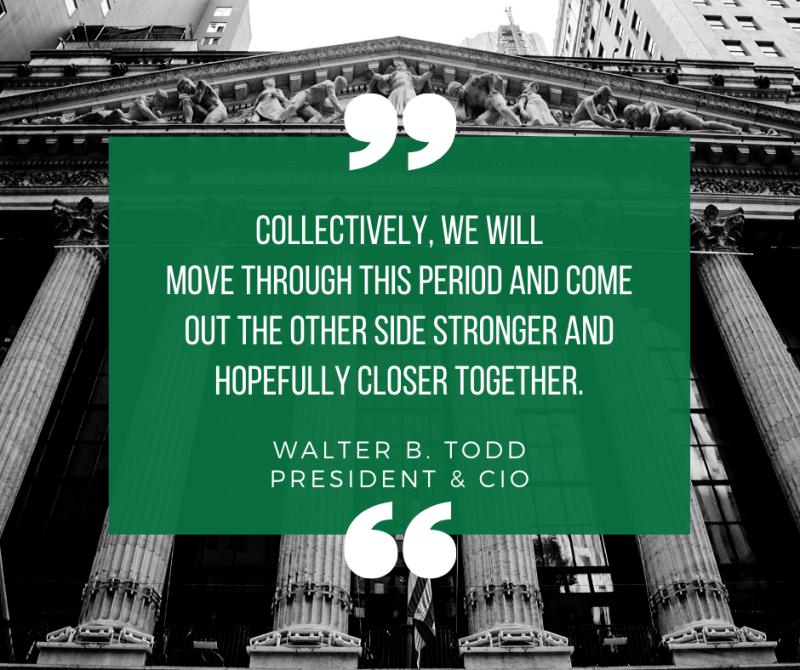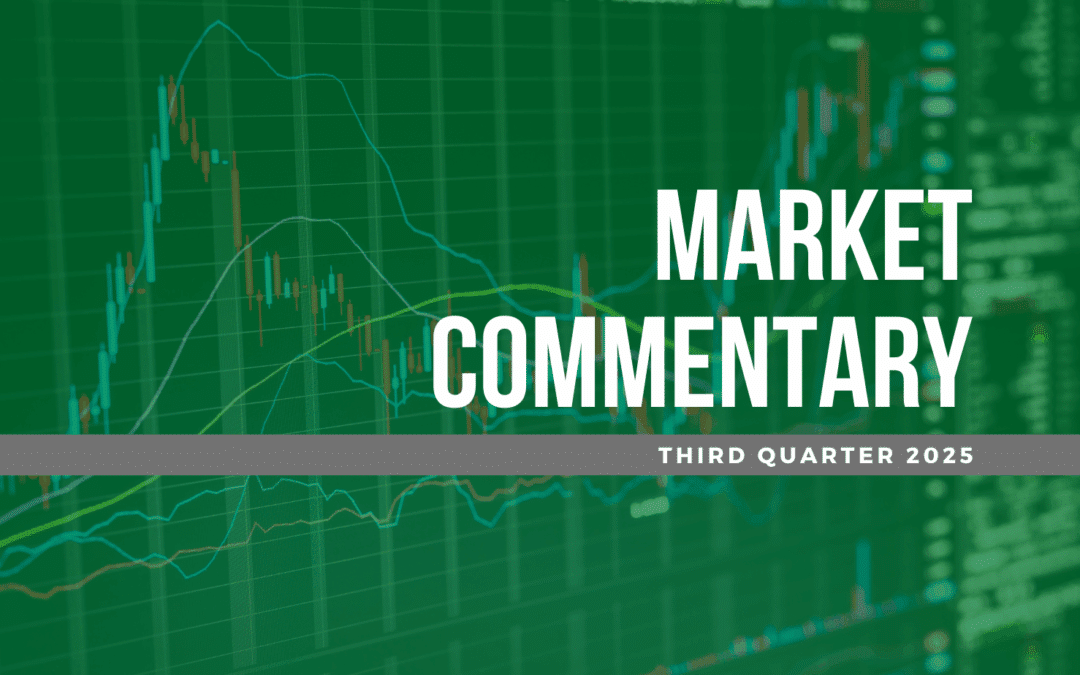Economic Outlook
By Dr. John McAlhany
The expected happened. COVID-19 ended the economic expansion and plunged the US into a recession, the first since the Great Recession eleven years ago. Officially, as determined by a committee at the National Bureau of Economic Research, the current recession began in mid-February as employment, income and spending peaked and then fell sharply as the virus shut down businesses and industries across the globe. Economists generally define a recession as two successive quarterly declines in economic growth – GDP. GDP declined by 4.8% in the first quarter which was prior to the full effects of the virus hitting. Second quarter data will not be reported until the end of July, but there is no doubt that growth will be negative. Jobs and spending have declined at historic rates, confirming that we are in a severe recession.
There is widespread uncertainty as to how bad the second quarter decline was, but it is expected to have been well above some earlier estimates of a 20% decline. Over 37 million people lost their jobs and filed for unemployment insurance and the unemployment rate skyrocketed. The unemployment rate was 3.5% in February and 4.4% in March at the beginning of the recession. Since then, the rate has increased to a high of 14.8% in April. With business and industries beginning to reopen in May and June and calling workers back, the unemployment rate has declined to 11.1% in June. A broader measure of underemployment that considers those that have quit looking for work and those that have been reduced to part-time was 18% in June. These rates are the highest since the Great Depression of the 1930’s and given the recent surge in the virus, they could go higher if businesses are forced to shut down again. The unemployment rate peaked at 25% during the Great Depression. However, given all the stimulus being injected into the economy by the government and the Federal Reserve (Fed), we do not expect it to come close to that level.
Unlike during the Great Depression, the Federal Reserve and the government are doing everything possible to provide support for the economy. The government opened the spigots early in the quarter and pumped over 3 trillion dollars into the economy. The Fed has kept interest rates near zero and they are aggressively buying securities to provide liquidity to the financial markets and support institutional lending. For the first time ever, the Fed began purchasing corporate bonds in addition to treasury bonds. By doing this, the Fed is providing direct support to businesses and industries rather than indirect support though the lending markets.
The Fed has, over the years, come to the rescue of the economy and they are doing whatever it takes during this pandemic. Chairman Powell has reiterated that the economy was fundamentally healthy prior to this pandemic and once the virus subsides the economy should see a “substantial” rebound. Quoting Chairman Powell, “you would not want to bet against the American economy.” He stresses that unlike the Great Recession of 2008, which was the result of a housing meltdown caused by excessive risk-taking by our banks, this recession is caused by an external event – the pandemic – and because of this difference, to further quote Chairman Powell, “we can get back to a healthy economy quickly.” We hope he is right.
Looking forward, uncertainty around the recovery and the volatility in the markets will persist until we turn the corner on the virus or find a vaccine. In addition to the pandemic, all the domestic unrest and this being an election year are stressing consumer confidence in having a quick economic recovery. The pandemic is the main issue, but just as important, we need to come together as a country. A united country is the heart of a strong economy. Stay healthy.
The Stock Market
By Walter Todd
July 3rd this year marked the 35th anniversary of the release of the movie “Back to the Future.” This is one of my favorite movies and I took the time to watch it (again) over the July 4th weekend. As Doc is explaining to Marty McFly how the time machine works, a recent meme of this scene on social media popped into my head. The caption reads Doc telling Marty: “Whatever you do, don’t set the date for 2020.” I can appreciate that given how this year is progressing, but the movie also reminded me of the fact that the equity markets seemed to do a trip back in time as well; almost to the point before all this virus craziness started. The S&P 500 came within 5% of its all-time high and for tech-heavy NASDAQ Composite, it made the trip all the way back and through the highs of February. Like the bolt of lightning that sent Marty back to the future in the movie, the fab 5 of Facebook, Amazon, Apple, Microsoft and Alphabet (Google) continue to power the market higher. It would be nice for them to share the love a little with some other names. We will watch to see if that happens in the coming months. For now, let’s take a look at what happened in the second quarter that ended June 30, 2020.
The S&P 500 posted its best quarter since 1998, rising 20.5%, including dividends. The index is lower by 3.1% for the first six months of the year. Small-cap equities caught up a touch with large-caps, gaining 21.9%, as measured by the S&P 600 index. Despite this gain, small-caps are still down 17.9% YTD. International stocks participated nicely but trailed US stocks with the Developed International Markets jumping 15.2% for the quarter (as measured by the EAFE Index). Emerging Markets (EM) fared better, up 18.1% for the quarter (using the MSCI Emerging Market Index) with a nice recovery in China. These indices were down 11.0% and 9.7%, respectively, YTD. Putting the US and International markets together, the MSCI All-Country World Index (ACWI) rose 19.4% for the quarter and is down just 6.0% for the year. Quite an amazing turnaround from the lows.
All eleven S&P 500 sectors were positive for the most recent three-month period. Consumer Discretionary, Technology, Energy and Materials led the rebound, each rising over 25% for the quarter. Utilities, Consumer Staples, Financials, Real Estate and Healthcare were in the bottom half, rising between 2% and 14% for the period. Leadership has shifted around over the course of weeks, with periods of “reopening” stocks and sectors leading and then “stay-at-home” sectors rallying as setbacks in the virus occur. Overall for the first six-months, the market has decidedly favored more secular growth and stay-at-home areas, with Technology and Consumer Discretionary (dominated by Amazon) the only positive sectors YTD. Healthcare and Communication Services are the only other sectors that have outperformed the broader market in the first half. At the bottom of the list, a mix of defensive and economically sensitive areas, Utilities, Industrials, Financials and Energy – each falling more than 10% YTD, with Energy down over 35%. The start of the third quarter has seen broadly the same trends, with secular growth dominating in Healthcare, Communications Services and Technology.
As we look toward the back half of the year, we have two opposing forces at play. We know that since 1950, this past quarter was the ninth time the S&P 500 gained 15% or more during a quarter (see chart below). In all prior eight instances the quarter that followed was positive with an average gain of 9.5%. At the same time, we know that when the S&P 500 is negative for the first six months of the year, the returns for the full year period tend to be sub-optimal and often negative. Which historic trend will win out? No doubt the lead up to the election in November will play a role in deciding. We continue to balance between secular and cyclical growth in our equity portfolios. Secular growth has been the clear winner YTD but valuations are worth watching here given the out-performance. Cyclical stocks present significant values in certain areas. In addition to sector dispersion, we have started to see geographic differences with international starting to outperform in recent weeks due to better virus outcomes and a weakening US dollar. We will see if this trend has legs after years of under-performance by ex-US equities.
Best Quarter for the S&P 500 Index since 1998
Source: LPL Research FactSet 6.30.2020 (1950 – Current)
| Qtr | Qtrly Gains > 15% | Next Qtr | Next Two Qtrs | Next Four Qtrs |
| Q3 1970 | 15.8% | 9.3% | 19.1% | 16.8% |
| Q1 1975 | 21.6% | 14.2% | 0.6% | 23.3% |
| Q4 1982 | 16.8% | 8.8% | 19.5% | 17.3% |
| Q4 1985 | 16.0% | 13.1% | 18.7% | 14.6% |
| Q1 1987 | 20.5% | 4.2% | 10.3% | -11.2% |
| Q2 1997 | 16.9% | 7.0% | 9.6% | 28.1% |
| Q4 1998 | 20.9% | 4.6% | 11.7% | 19.5% |
| Q2 2009 | 15.2% | 15.0% | 21.3% | 12.1% |
| Q2 2020 | 20.0% | ? | ? | ? |
| Average | 9.5% | 13.9% | 15.1% | |
| Median | 9.0% | 15.2% | 17.0% | |
| % Positive | 100% | 100% | 87.5% |
The Bond Market
By John Wiseman
With a pledge from the Federal Reserve to keep its benchmark rate at the zero bound and to amass US Treasury bonds through quantitative easing, rates remained stable for the quarter after their big drop in the first quarter. The 10-Year Treasury Note finished at a yield of 0.66%, only 1 basis point lower than the beginning of the quarter, but 126 basis points lower than at the start of the year. The 2-Year Treasury Note ended the quarter at 0.15%. The quarterly total return for the 10-Year and 2-Year Treasuries were 0.67% and 0.10%, respectively. The Federal Reserve’s balance sheet is greater than $7 trillion, which includes $4.2 trillion in Treasury securities – a fifth of the debt outstanding. The markets are comfortable with the increasing debt issuance of the Treasury and the purchase of that debt by the Federal Reserve. We are skeptical that this is a sustainable long-term solution and suggest longer rates need to rise for new buyer demand. We remain underweight duration.
As we mentioned in the first quarter commentary, credit markets were frozen in March. In response to this, the Federal Reserve “dusted off” lending facilities used during the financial crisis of 2008 and introduced some new ones. These programs calmed markets and the rebound in corporate bond performance was quite dramatic posting a 7.88% return as measured by the ICE BofA 1-10 Year Corporate Index. Of course, this comes on the heels of the 2nd worst quarterly performance since the index was formed 36 years ago. The resulting performance for the 1st half of the year was 4.18%. BBB-rated bonds were the greatest beneficiaries of these programs – outperforming A-rated bonds by 370 basis points for the quarter. Companies continue to issue record amounts of debt at these lower rates. We still see the credit sector as relatively attractive in the fixed income space, but since credit spreads have recovered much of the widening that occurred in March, individual bond selection will be the most important determinant of performance going forward.
The Federal Reserve’s lending programs weren’t limited to company debt. Details emerged during the quarter about the Municipal Liquidity Facility helping yields in this sector to move lower. The Barclays 5-Year Municipal Index ended the quarterly period with a total return of 3.26%. It is up 2.18% for the year. The yield ratio of municipal bonds to treasury bonds remains at a still high 130%, but absolute yields are quite low. There is much discussion in Congress about direct aid to states as well as loosening the restrictions on refundings for municipalities to take advantage of these low rates. As the election comes more into focus, this market will discount future tax policy. It is evident that more tax revenue will be needed to service the federal debt. The demand for tax-exempt offerings should remain high even as some municipalities struggle to regain lost tax revenues due to virus lockdowns.
Market Indicators
Source: Bloomberg
| QTD 2020 Total Return1 | YTD 2020 Total Return2 | 52 Week Total Return3 | |
| S&P 500 | 20.54% | -3.09% | 7.49% |
| DJIA | 18.51% | -8.43% | -0.54% |
| NASDAQ | 30.95% | 12.74% | 27.05% |
| S&P 400 | 24.07% | -12.78% | -6.71% |
| S&P 600 | 21.94% | -17.86% | -11.31% |
| MSCI EAFE | 15.15% | -11.03% | -4.63% |
| MSCI Emerging Markets | 18.14% | -9.70% | -3.11% |
| MSCI ACWI | 19.41% | -5.98% | 2.66% |
| Barclays Int. Gov’t/Credit | 2.81% | 5.28% | 7.12% |
| Barclays 5-Year Municipal | 3.26% | 2.18% | 3.80% |
1. 03.31.20 to 06.30.20
2. YTD through 06.30.20
3. 12 months-ended 06.30.20
The information contained within has been obtained from sources believed to be reliable but cannot be guaranteed for accuracy. The opinions expressed are subject to change from time to time and do not constitute a recommendation to purchase or sell any security nor to engage in any particular investment strategy. Investment Advisory Services are offered through Greenwood Capital Associates, LLC, an SEC-registered investment advisor.










